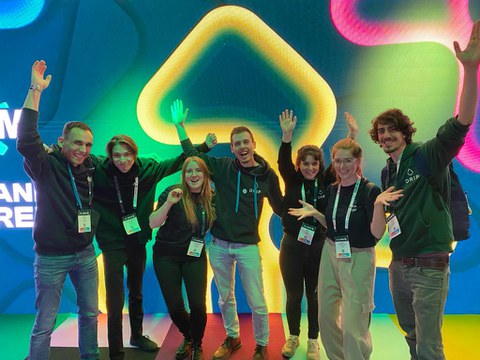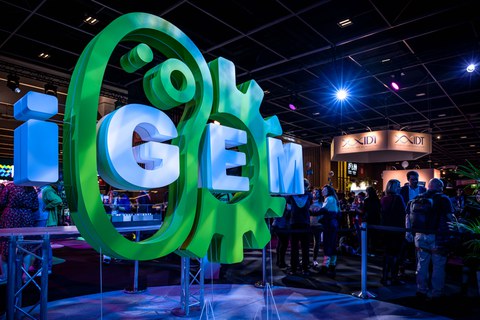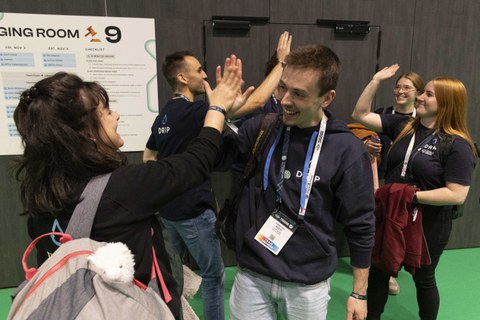Feb 21, 2024
TU Dresden Team Places in Top10 at the World’s Largest Synthetic Biology Competition

Das iGEM Team
A team of TU Dresden students placed in the top ten at the 2023 International Genetically Engineered Machine (iGEM) competition with their innovative method to remove water micropollutants named “Diatom-based Remediation using Immobilized Proteins” (DRIP). The project also earned them a gold medal and received nominations for Best Bioremediation Project, Best Presentation, and Best Education.
In the 20th edition of the International Genetically Engineered Machine (iGEM) competition, 400 teams from around the world set out to use synthetic biology to solve local environmental and human health challenges. The TU Dresden DRIP team, an interdisciplinary team of eight TU Dresden Master’s and Diploma students, decided to combat micropollutants in water.
Painkillers and Microplastics
“Water pollution is one of the biggest environmental threats worldwide,” says Tobias Fietze, TUD iGEM team leader. “It is a challenge that is important both locally and globally. In our project we chose to focus on two of the most common pollutants.”
“Diclofenac is one of the most common prescribed medical substance which is also found in rivers or lakes in Germany. It is an active ingredient in many painkillers and enters the water through human excretion or simply flushed down the toilet by people if the medication is expired,” explains Caroline Breitenberger. “Then there’s microplastics. These tiny pieces of plastic can be invisible to a human eye, yet they are now omnipresent in aquatic ecosystems.”
Common Diatom – an Unsung Hero
Common wastewater treatment plants are not able to effectively remove diclofenac or microplastic from the water. Therefore, there is an urgent need to identify alternative technologies for the effective removal of these compounds. The TUD iGEM team developed a new method to degrade diclofenac and nano-plastic PET in a sustainable and bio-based way with the use of… Diatoms.
Diatoms are microscopic algae present in almost all sunlit aquatic habitats. They are most well known for their unique silica cell walls but on a global scale, they are one of the most important groups of photosynthetic organisms being responsible for ~20% global biomass production. “Observed through the microscope, diatoms are some of the most beautiful organisms on Earth. They are easy to grow and culture in a laboratory and have the potential to be used for a variety of different biotechnological applications,” explains Dr. Nicole Poulsen, scientist at the Kröger group at the B CUBE – Center for Molecular Bioengineering and the DRIP practical supervisor. “In fact fossilized diatoms (diatomaceous earth) have been utilized for decades as a highly effective material in pool and beer filtration due to the nanoporous silica cell wall structures that can filter microscopic contaminants from the water that passes through the filter.”
“Diclofenac and plastic can both be degraded using specific enzymes. The challenge is to cost-effectively produce these enzymes and introduce them into the water and filter them out afterward. In this innovative approach, we harness the inherent diatom silica-forming machinery to genetically engineer them to produce these pollutant degrading enzymes and embed them into their cell walls in vivo,” says Anne-Katrin Wilbrink from the iGEM team. This method offers a natural and sustainable means of enzyme immobilization and water purification. “There are other ways of immobilizing the enzymes on silica on an industrial scale. However, with our method, we get to skip a very energy, chemical, and resource-costly step of purifying the enzymes,” says Matthias Frank from the DRIP team.
Interdisciplinary Approach
This year’s team members came from a variety of fields, studying biochemistry, molecular biosciences and productive biosystems, industrial engineering, and water management.
“This interdisciplinarity was the key to our success. Everybody brought something to the table and helped the project move forward,” explains Johannes Radde, DRIP team leader. “It was also one of the biggest challenges for us. We were all able to speak the same language but, with different scientific backgrounds and expertise, we had to learn how to find a way to communicate our ideas and scientific knowledge effectively.”
Participation in the iGEM competition is a unique experience for students. “We learned so much about the subject matter but, at the same time, we had many opportunities to improve on different fronts. We worked on our communication skills, learned how to network, got in touch with the public through events and social media, and got funding by reaching out to a variety of institutes and companies. One can see it as a bite-sized version of running a scientific group or a company,” says Mona Sabha.
Team Members: Tobias Fietze, Johannes Radde, Matthias Frank, Anne-Katrin Wilbrink, Mona Sabha, Aleksandra Kievets, Caroline Breitenberger, Lanny Seraphim Thomas
Instructors: Dr. Nicole Poulsen
Supervising PIs: Prof. Dr. Thorsten Mascher, Prof. Dr. Nils Kröger
To learn more about their Diatom-based Remediation using Immobilized Proteins method, visit the team’s website (https://2023.igem.wiki/tu-dresden/).
About iGEM
The International Genetically Engineered Machine (iGEM) is an annual worldwide synthetic biology competition aimed at high school students, undergraduates, Master’s students, entrepreneurs, and community laboratories. Since its start in 2004, the competition developed into the largest and most prestigious student competition in the field of synthetic biology.
Contact:
Thorsten Mascher
Professor of General Microbiology
TU Dresden
Email: thorsten.mascher@tu-dresden.de
Tel. +49 351 463-40420


